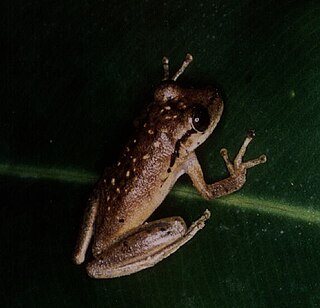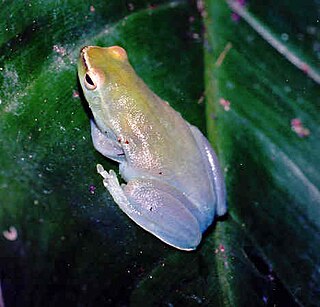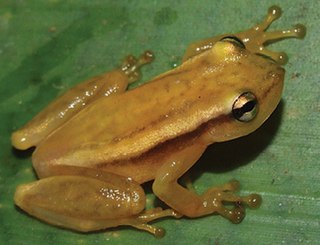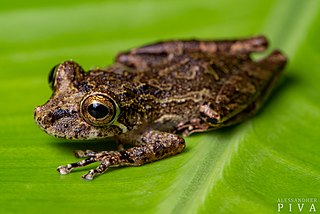
Scinax is a genus of frogs in the family Hylidae found in eastern and southern Mexico to Argentina and Uruguay, Trinidad and Tobago, and Saint Lucia. These are small to moderate-sized tree frogs, drably colored. Duellman and Wiens resurrected this genus in 1992. The name originates from the Greek word skinos, meaning quick or nimble.

Sphaenorhynchus is a genus of frogs in the family Hylidae. They are also known as lime treefrogs or hatchet-faced treefrogs. They are found in the Amazon and Orinoco River basins of South America, the Guianas, Trinidad, and southern and eastern Brazil. The majority of the species are associated with the Atlantic Forest domain in Brazil.
Dendropsophus berthalutzae is a species of frog in the family Hylidae. It is endemic to southeastern Brazil and occurs in the coastal lowlands and the Serra do Mar in Espírito Santo, Minas Gerais, Rio de Janeiro, São Paulo, and eastern Paraná states. It is named in honor of Bertha Lutz, a Brazilian zoologist and feminist. Common name Bertha's treefrog has been coined for it.
Boana latistriata is a species of frog in the family Hylidae. It is endemic to Brazil and only known from its type locality, Itatiaia National Park, and from Marmelópolis, both in the state of Minas Gerais. The specific name latistriata refers to the wide stripes on the back of this frog.
Phyllodytes punctatus is a species of frogs in the family Hylidae endemic to Brazil. People have seen it as high as 140 meters above sea level.

Phyllodytes wuchereri is a species of frog in the family Hylidae endemic to Brazil in the Atlantic forest in the state of Bahia. This frog has been observed 400 meters above sea level.

Scinax alter, the Crubixa snouted treefrog, is a species of frog in the family Hylidae endemic to Brazil.

Scinax boulengeri is a species of frog in the family Hylidae. It is found in Colombia, Costa Rica, Nicaragua, Panama, and possibly Honduras. Its natural habitats are subtropical or tropical moist lowland forests, intermittent freshwater marshes, pastureland, plantations, rural gardens, and urban areas. It has been found as high as 600 meters above sea level.
Sphaenorhynchus platycephalus, commonly known as the South American lime treefrog or Lutz's lime treefrog, is a species of frog in the family Hylidae. It is endemic to south-eastern Brazil where it occurs in the Serra do Mar and Serra da Mantiqueira ranges in the states of Rio de Janeiro, São Paulo, and Minas Gerais. However, Araujo-Vieira and colleagues suggests that the Serra da Mantiqueira population could represent Sphaenorhynchus canga; the two species are similar.
Hylodes amnicola is a species of frog in the family Hylodidae. It is endemic to Minas Gerais in Brazil. It has been observed 1400 meters above sea level.

Phasmahyla spectabilis is a species of frog in the subfamily Phyllomedusinae. It is endemic to Brazil and known from the north-eastern Minas Gerais and adjacent southern Bahia. It occurs in fragments of Atlantic Forest at elevations of about 800 m (2,600 ft) above sea level.People have seen it as high as 850 meters above sea level.
Scinax cabralensis is a species of frog in the family Hylidae. It is endemic to Brazil.
Scinax tigrinus is a frog in the family Hylidae. It is endemic to Brazil.
Scinax cabralensis is a frog in the family Hylidae. It is endemic to Brazil. Scientists observed some of these frogs 1070 meters above sea level.
Scinax cretatus is a frog in the family Hylidae endemic to Brazil.
Scinax montivagus is a frog in the family Hylidae. It is endemic to Brazil. It is known solely from its type locality in the Chapada Diamantina in the Espinhaço Range.
Sphaenorhynchus canga is a frog in the family Hylidae. It is endemic to Minas Gerais, Brazil.
Nyctimantis pomba is a frog in the family Hylidae, endemic to Brazil. Scientists have seen it in exactly one place, 233 meters above sea level in the rainforest in Minas Gerais.

Ololygon is a genus of frogs in the family Hylidae. The majority of species in it are endemic to the Atlantic Forest of eastern Brazil, although the range of some species, including Ololygon aromothyella and Ololygon berthae, is known to extend south to northeastern Argentina, southern Paraguay, and Uruguay.
Bokermannohyla sagarana is a species of frog in the family Hylidae. It is endemic to the Espinhaço Mountains in the state of Minas Gerais, southeastern Brazil. Its specific name refers to the novel Sagarana by João Guimarães Rosa.






